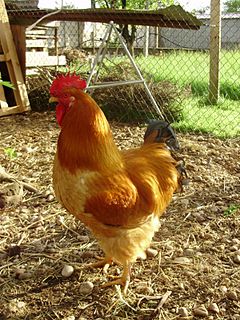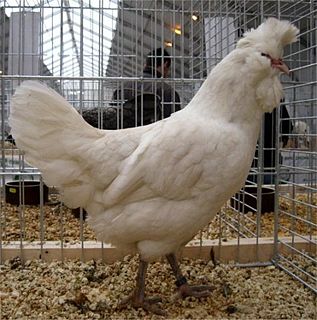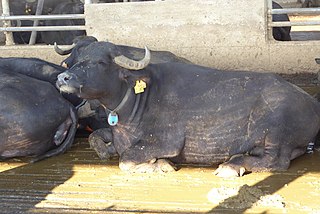
Stura[sty.ʁa] was a department of the French Consulate and of the First French Empire in present-day Italy. It was named after the river Stura di Demonte. It was formed in 1802, when the Subalpine Republic was annexed to France. Its capital was Cuneo.

The Ancona is a breed of chicken which originated in the Marches, region of Italy, but which was bred to its present type mainly in the United Kingdom in the nineteenth century. It is named after the city of Ancona, capital of the Marche. It is popular in Britain and the United States, but uncommon in Italy; an initiative to re-establish it in its native area and preserve its biodiversity was launched in 2000. There are also Ancona bantams.
The Bianca di Saluzzo is a traditional breed of chicken originating in the Piedmont region of north-western Italy. It takes its name either from the town of Saluzzo, in the province of Cuneo, or from the former Marquisate of Saluzzo, which approximately coincides with its area of distribution. It may also be called the Bianca di Cavour, after the nearby town of Cavour, in the province of Turin.
The Ermellinata di Rovigo is a modern Italian breed of dual-purpose chicken. It originates in the city of Rovigo in the Veneto region of north-eastern Italy, from which it takes its name. It was created between 1959 and 1965, principally from Sussex and Rhode Island Red parentage.

The Robusta Lionata is a recent dual-purpose breed of chicken originating in the city of Rovigo in the Veneto region of north-eastern Italy. It was created between 1959 and 1965, by cross-breeding Buff Orpingtons with the commercial strain known in Italy as "White America".
The Robusta Maculata is a recent dual-purpose breed of chicken originating in the city of Rovigo in the Veneto region of north-eastern Italy. It was created between 1959 and 1965, by cross-breeding Buff Orpingtons with the commercial strain known in Italy as "White America".
The Romagnola is a traditional dual-purpose breed of chicken from the Emilia-Romagna region of Italy. Formerly widespread in central Italy, it came close to extinction in the late 20th century. In early 2012 the population was recovering and the breed was awaiting official recognition by the Federazione Italiana Associazioni Avicole, the federation of Italian poultry associations.
The Pépoi or Pepoi is a rustic dual-purpose breed of small chicken from north-eastern Italy, particularly the Veneto and Friuli-Venezia Giulia regions. It is not officially recognised as a breed in Italy, but is being considered for recognition.

The Mugellese, also known as Mugginese, is a rustic dual-purpose breed of small chicken or bantam from Tuscany, in central Italy. It takes its name from the historic Mugello region to the north-east of Florence. It is not officially recognised as a breed in Italy, but is being considered for recognition.
The Mericanel della Brianza is a breed of small chicken or bantam from Lombardy, in northern Italy. It takes its name from the Brianza, an area to the north-east of Milan, and from mericanell, a Lombard diminutive of merican "American". In early 2012 it was the only officially recognised Italian bantam breed.

The Padovana or Padovana dal gran ciuffo is an ancient Italian breed of small crested and bearded chicken. It originates in, and is named for, the city and surrounding province of Padua, in the Veneto region of north-eastern Italy. Despite continuing discussion surrounding its true origins, it is recognised in Italy as an indigenous Italian breed.

The Polverara, also known as Schiatta (Italian) or S'ciata (Venetian), is an ancient breed of crested chicken from the area of Polverara in the province of Padua, in the Veneto region of north-eastern Italy.

The Valdarno is a breed of black dual-purpose chicken from the lower part of the Valdarno, the valley of the Arno river, in Tuscany, central Italy. It became virtually extinct in the 20th century, but the population is recovering. It is a quite different breed from the Valdarnese, which originates in the upper Valdarno, and is white.

The Valdarnese, also referred to as Valdarnese Bianca, Valdarno Bianca or Pollo del Valdarno, is a breed of large white chicken from the upper Valdarno, the valley of the Arno river, in Tuscany, central Italy. It became virtually extinct in the 20th century, but the population is recovering. It is a different breed from the Valdarno chicken, which originates in the lower part of the Valdarno, and is black.

The Siciliana is an ancient breed of chicken from the Italian island of Sicily. It is notable for its unusual double or rose comb, for the early age at which birds reach maturity, and for the unusual shape of the eggs. The Sicilian Buttercup, bred in Australia, Great Britain and the North America, derives from it, but its long separation from the original stock has led to marked differences between the two.

The Italian Mediterranean Buffalo or Bufala Mediterranea Italiana is an Italian breed of water buffalo. It is of the River sub-type of water buffalo and is similar to the buffalo breeds of Hungary, Romania and the Balkan countries. It is the only indigenous water buffalo breed in Italy. A herd-book was opened in 1980, and the breed was officially recognised in 2000.
The Sambucana or Demontina is a breed of upland sheep from the province of Cuneo, in Piemonte, north-west Italy. It takes its name from the comune of Sambuco in the Valle Stura di Demonte, the area where it is thought to have originated; the other name of the breed, Demontina, derives from the name of that valley. The Sambucana is also raised in the adjoining valleys, the Valle Gesso, the Valle Grana and the Valle Maira. It is one of the forty-two autochthonous local sheep breeds of limited distribution for which a herdbook is kept by the Associazione Nazionale della Pastorizia, the Italian national association of sheep-breeders.
The Delle Langhe, also called Pecora delle Langhe or Langarola, is a breed of domestic sheep indigenous to Piedmont, in north-western Italy. It is a rough-woolled breed of southern Mediterranean type, and originates from the mountainous area of the Alta Langa, where the Apennines meet the Alps, in the province of Cuneo. It is raised mainly in the Langhe, but is found in several other regions of Italy including Abruzzo, Basilicata, Emilia–Romagna, Liguria and Tuscany.
The Roccaverano is an indigenous breed of large domestic goat from the Langhe, in the provinces of Asti and Cuneo, in Piemonte in north-western Italy. It is raised mainly in the Langa Astigiana, mostly within the Comunità montana Langa Astigiana Val Bormida, and is named for the town and comune of Roccaverano in that area. The origins of the breed are unknown.

The Pesio is a 48.8-kilometre (30.3 mi) long river in northwestern Italy (Piedmont).











